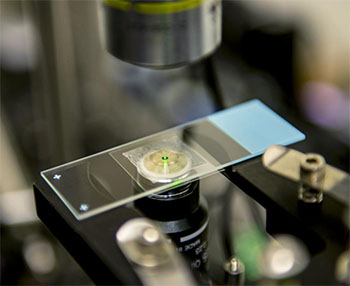
In the custom laser trap devised by the University of Washington team, doped nanocrystals stimulated by infrared radiation emit upconverted (green) anti-Stokes photoluminescence , which carries off heat and cools the surrounding aqueous solution. [Image: Dennis Wise/University of Washington]
Laser cooling and trapping of atoms, the stuff of Nobel Prize-winning research, has led to the isolation of Bose-Einstein condensates and the development of new kinds of ultraprecise optical clocks. But could lasers be used to refrigerate bulk liquids—even liquid water? A team of scientists at the University of Washington (UW), USA, has reportedly found a way to do so, through a novel approach that uses doped, upconverting yttrium lithium fluoride (Yb3+:YLF) nanocrystals as a local “refrigerant” dispersed in aqueous media (Proc. Natl. Acad. Sci. USA, doi: 10.1073/pnas.1510418112).
The ability to cool aqueous liquids using lasers has a number of possible applications in biomedical studies—for example, in slowing down processes in living cells to investigate their biophysics on a very local level. But there’s been a problem: water itself is quite good at absorbing near-infrared radiation, which would tend to warm up the background solvent rather than cool it.
Using doped nanocrystals as local Freon
To provide a route to laser-driven refrigeration of liquids, the UW team built on long-standing work using lasers to cool solid-state materials. In 1995, scientists at Los Alamos National Laboratory demonstrated that rare-earth-doped fluoride glass that emitted blue-shifted (anti-Stokes) radiation, when optically excited by lasers at a specific wavelength could be cooled in vacuum—with the higher-energy upconverted photons serving to carry off heat. More recently, researchers reported the laser-cooling of upconverting Yb3+:YLF crystals to cryogenic temperatures in vacuum using the same approach (Opt. Lett., doi: 10.1364/OL.38.001588).
The UW scientists hit upon the idea of using nanocrystals of the same material as local refrigerants in aqueous solutions. Under the idea, the crystals, illuminated with tightly focused infrared laser light, would cool as they gave off higher-energy anti-Stokes radiation, creating a local refrigeration field around the particle that would chill the surrounding liquid.
Nanocrystal slowdown
To test the idea, the team created a “home-built” single-beam laser-trapping instrument using a modified commercial optical-tweezer kit, and trained a 1,020-nm laser beam onto a glass slide containing an aqueous solution of the Yb3+:YLF nanocrystals. The same instrument allowed the scientists to optically verify, through an analysis of the cold Brownian motion (CBM) of the nanocrystals, that the as the lasers refrigerated a specific nanocrystal, the fluid surrounding the particle was cooled as well—indeed, the slowdown in the crystals’ CBM suggested local cooling of the surrounding liquid by as much as 21 °C.
Thus far, the approach has been tested only on a small scale (essentially cooling of a single nanocrystal), and work remains to drive down the energy cost of the technique, which is still relatively high. Still, the UW team believes that as these problems are resolved, the approach could ultimately have applications in “precision temperature control in integrated electronic, photonic, and microfluidic circuits, as well as triggering and probing fundamental metabolic processes.” A particularly interesting use, the scientists say, could be in slowing down the rapid shifts of proteins to investigate the biophysics of dynamic processes such as protein folding and the amblings of molecular motors.
